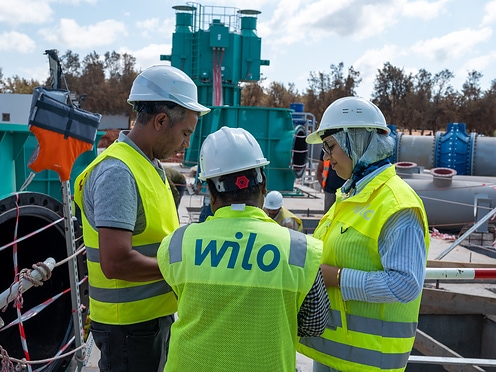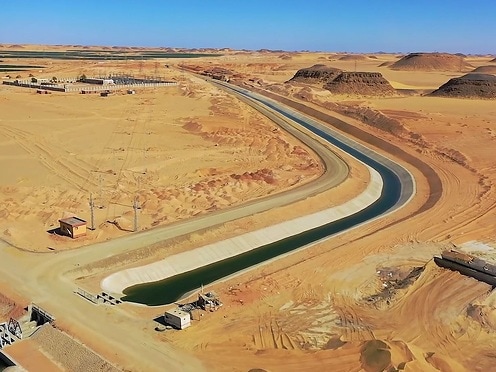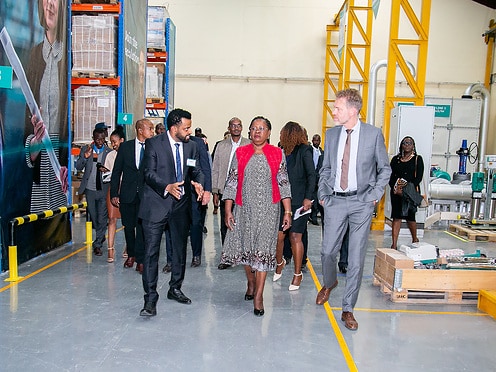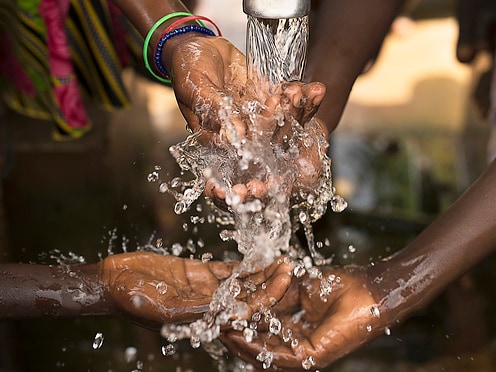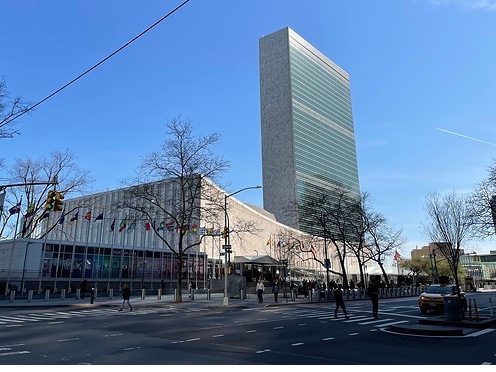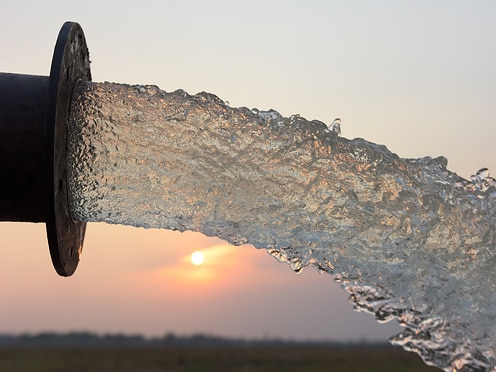Water – every drop counts.
Eight tips for saving water.
Earth Day raises awareness every year of just how valuable our planet’s natural resources are for us and future generations. One of these vital resources for our future is at risk, yet we take it for granted every day: water. Find out more about the reasons for water shortages and how you can easily help to save water.

One in ten people worldwide don’t have enough water
The German aid agency Welthungerhilfe paints a worrying picture: a growing population, climate change, irregular rainfall and overuse lead to water shortages. Around 785 million people currently face severe water shortage, the equivalent of one in ten people. A growing global population puts increased pressure on available water reserves.
Water shortages in Europe
A current example is Catalonia in Spain. There has been a severe shortage of water here for more than three years. The government has declared a state of emergency in the region. And Spain is no exception: many countries have been suffering from drought and falling ground water levels for years. The Intergovernmental Panel on Climate Change predicts that a total of 44 million Europeans will be affected by water shortages in 2070. Rivers in central and southern Europe could be carrying up to 80 per cent less water by then. The European Parliament therefore wants to implement stronger measures to protect and improve water resources. In light of the escalating situation, the parliament and member states are currently working on revising water policy measures. The parties involved are concentrating in particular on the integrated management of surface and ground water.
8 ways how you can help protect water
Against the backdrop of these challenges, individuals might ask themselves: what can I do? The good news is that you can easily change something through the deliberate choices you make on a daily basis. Here are eight small tips that can make a big difference.
Tip 1: Save water at home

When buying new household appliances, in particular washing machines and dishwashers, keep an eye on water and energy consumption. Go for models that are not only energy-efficient but also use less water.
When using the new appliances, you can also save water by only switching on the dishwasher and washing machine when they’re fully loaded. This requires considerably less water than washing up by hand or turning on machines that are only half full.
And don’t forget to use the eco or water-saving programmes on your appliances.
Tip 2: Save water in the kitchen

Cooking uses a lot of water, but with a few simple tricks you can save water effectively. Use a bowl to wash vegetables instead of running water from the tap. You can then water your houseplants with the water you’ve collected.
Always defrost frozen food in the fridge instead of under running water. This wastes large quantities of water unnecessarily.
When cooking, you should only use as much water as is strictly necessary – this also saves energy as there is less water to heat up. You can also save water by using a pressure cooker, which cooks quicker and uses less water and energy in the process. If you wash dirty dishes and pots in a water bath, you can save additional water.
Tip 3: Reduce your water consumption in the bathroom

Showers: taking a bath might be relaxing but it uses up to 150 litres of water. Showering on the other hand often uses less than a third of this amount.
Upgrade to a water-saving shower head: simply replacing your shower head can work wonders. Modern water-saving shower heads are designed to reduce the flow of water without having a negative effect on your shower experience. This can reduce your water consumption in the shower by up to 50 per cent.
Tip 4: Big water savings on the toilet
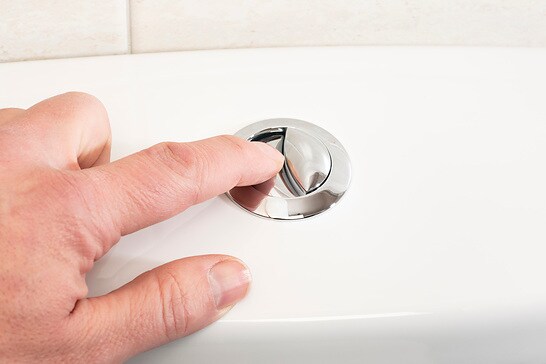
Did you know that flushing the toilet is one of the things that uses the most water at home? On average, around 35 litres of drinking water are used every day just for flushing – and for older models, as much as 45 litres. But you can take action by using the half-flush button as often as possible.
If you still have an old cistern, think about replacing it. Modern cisterns are designed to dramatically reduce water consumption, often as much as by half.
Tip 5: Save water in the garden

To use water efficiently in your garden, you should water your plants at night or in the early morning or late evening. The water evaporates more slowly at these times meaning that your plants can absorb more of it.
Use rainwater: one of the best ways to save water is collecting rainwater in barrels or other containers. You can then water plants with this natural water free of charge. It’s not only good for the environment but also great for the plants as rainwater is often softer than tap water.
When watering, you should water directly at soil level and close to the roots instead of sprinkling the water over the leaves. This ensures that the water gets where it’s really needed and reduces evaporation. It’s also better to water plants less frequently but thoroughly so that the soil gets plenty of moisture. This creates deeper root systems and makes your plants more resilient.
Mow the lawn less often and let the grass grow longer. This helps the lawn retain moisture better. A long lawn provides shade for the soil and reduces evaporation. This leads to reduced water consumption.
Tip 6: Live sustainably and conserve resources

Make a conscious decision about what you eat. Buying local and seasonal products as well as organic food can significantly reduce your indirect water consumption. Every product that we consume has a certain amount of “virtual water”, i.e. water required to produce it. Here are two examples: one kilogramme of beef requires around 15,000 litres of water whereas a cup of coffee in the morning uses around 140 litres of water.
As well as making conscious decisions about food, it’s also important not to flush any harmful substances such as paint residues or medication down the toilet or sink. This not only pollutes the sewage system and the environment, but also increases the need for treated drinking water.
Purchasing non-food items also drives up water consumption. For example, an average of 2,500 litres of water are needed to produce a cotton T-shirt.
Tip 7: Save water at the office

Around 400 litres of water are needed for 1 kg of paper. That means that 1,000 litres of water are need for a packet of photocopy paper weighing around 2.5 kg. It’s therefore a better idea to use digital documents and print less or not at all. Another beneficial option is to set your printer to double-sided printing.
Tap water is one of the best-supervised provisions in many countries and offers an environmentally friendly and cost-effective alternative to plastic water bottles. Installing water filters in your office can further improve the water quality and alleviate any concerns about taste or impurities.
Glass jugs or recyclable water bottles in the office can further encourage employees and colleagues to drink tap water. This not only reduces the use of plastic bottles but also the indirect water consumption as considerably more resources and water are required to produce and transport bottled water.
Set and commit to water saving goals: Similarly to other sustainability goals, companies can also set goals for water consumption. Measuring and publishing water consumption reveals the progress made and teams may be motivated to reduce consumption further.
Tip 8: Use water less and more efficiently with modern technology
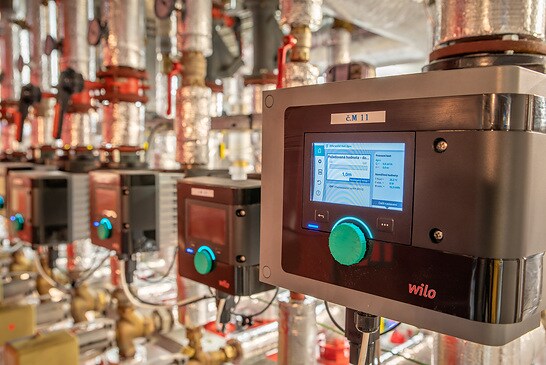
Outdated, conventional water pumps usually run continuously and guzzle energy at home or at work (pumps make up around 10 per cent of global energy consumption). Modern pump technologies are a fundamental game-changer. They save energy as they only operate when there is actual need. This not only prevents unnecessary energy consumption but also optimises water circulation and use.
How does it work? Modern pump systems are fitted with sensors and intelligent control systems that detect current water requirements. They adapt their mode of operation dynamically – in other words, they switch on when water is required and switch off when there is no demand. The pumps’ modern materials also contribute to a high degree of efficiency. Special coatings such as Ceram-CT surfaces further improve the pumps’ efficiency by minimising internal friction. Less friction means less energy consumption when pumping the same amount of water.
Smart pump systems have a wide range of applications. They are employed to use rainwater conveniently and effectively to water the garden. In heating and cooling systems, they provide precise temperature control with minimum water consumption. In addition, they contribute to considerable water and energy savings in industrial applications with optimised process control.
Tackling water shortage together
The threat of water shortage is a challenge facing us all. We are therefore all called upon to act – whether as individuals, companies, or political entities.
The available water resources can be used more efficiently if companies invest in sustainable technologies and optimise their processes. The use of smart pump technologies not only reduces our carbon footprint but also saves a considerable amount of water.
Individuals can take various measures to save water that are often easier to implement than you might think. Whether this involves consumer awareness, optimising your own water and energy consumption in your home, or using sustainable technologies – every step counts. We don’t have to completely overhaul our way of life to make a difference. Just little changes in our day-to-day lives can have a big impact and help protect our planet’s most valuable resource.

